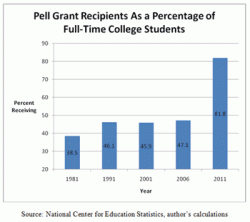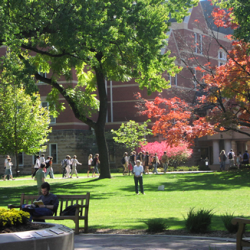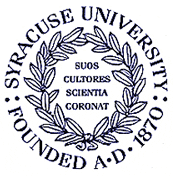
Many politicians, including senators such as Tom Harkin and Dick Durbin, have grown indignant over the allegedly vast amounts of higher education money captured by for-profit institutions via the Pell Grant program. In fact, they consider this something of a scam. The truth, of course, is that throughout its history, including now, the vast majority […]
Read More
Universities are in the knowledge business, and the creation and dissemination of it is at the very core of what colleges do. Yet some forms of knowledge about higher education itself are either unknown, or hidden from the public. Why? Release of the information would prove embarrassing and possibly even costly to the school. 1. […]
Read More
The vast majority of American colleges and universities make admission decisions without considering the financial need of applicants. Only a handful of private institutions admit their entire first-year class need-blind and then fully meet the financial need of all of their admitted students through a combination of grants, loans and employment opportunities. These institutions tend […]
Read More
Now that Paul Ryan has joined the Republican ticket, it’s worth considering how his much-discussed budget changes higher education. Ryan wants to cap the maximum amount of Pell Grant awards at the current level of $5,550, eliminating the automatic increase according to inflation. Ryan would also shore up the eligibility requirements, adding a maximum income […]
Read More
It’s called “the Bennett Hypothesis,” and it explains–or tries to explain–why the cost of college lies so tantalizingly out of reach for so many. In 1987, then Secretary of Education William J. Bennett launched a quarter century of debate by saying, in effect, “Federal aid doesn’t help; colleges and universities just cream off the extra […]
Read More
When individuals seek higher education, why should all of us have to pay? After all, individuals decide whether to seek a college degree based on their own calculations of expected costs and benefits. That taxpayers must bear the burden of financial aid to these individuals seems unfair. Given the billions of dollars governments pay individuals […]
Read More
At Bloomberg News, Virginia Postrel writes about how federal subsidies intended to make college more affordable have instead encouraged rapidly rising tuitions, in a column entitled, “U.S. Universities Feast on Federal Student Aid.” Education analyst Neal McCluskey links to four studies showing that increased government spending on student aid results in large tuition increases. As […]
Read More
An elephant in the room that universities avoid is how their system is rigged to serve the rich over the poor. An October study by the American Enterprise Institute (AEI) entitled “Cheap for Whom?” showed one way that the university system is rigged in favor of the rich. It said: “Average taxpayers provide more in subsidies […]
Read More
Are for-profit colleges and universities getting a raw deal from the government compared to their more elitist peers in the private non-profit sector of American higher education? Vance H. Fried, writing in a recent policy analysis brief published by the libertarian think-tank, the Cato Foundation, argues just that. Fried is a former private-practice attorney, oil […]
Read More
By Andrew Gillen, Matthew Denhart, and Jonathan Robe As they defend tuition increases to irate students and parents, college and university leaders often argue that tuition does not cover their costs and that they are therefore subsidizing their students’ educations. Take, for example, what Southwestern College President Dick Merriman said in an October 2010 piece for The Chronicle of Higher […]
Read More
Today the Obama Administration unveiled its long-anticipated and highly controversial final gainful employment (GE) regulation that ties program eligibility for federal student aid to new metrics that are based on student loan repayment rates. Under the new GE rule, a vocational program can qualify as leading to gainful employment and remain eligible for federal aid […]
Read More
In recent years Syracuse University has decided to make its undergraduate student body more “diverse” and “inclusive”–code words for racial preferences that translated into a freshman class for the fall of 2010 that was 30 percent black and Latino. The class of 2014 was also 26 percent eligible for federal Pell grants to low-income students. […]
Read More
I’ve argued that there’s a way for-profit colleges to increase their credibility as genuine educational institutions rather than dropout factories running on federal student aid: they could focus their efforts and investment dollars on creating high-quality courses and courseware that the non-profit world might respect. And now, one for-profit institution, Capella University, seems to be […]
Read More
For-profit colleges are having a tough time these days, thanks to the Obama Education Department’s looming new “gainful employment” rules that threaten federal aid cutoffs to an industry that derives 87 percent of its revenue from government loans and grants to its students—along with steep declines in new enrollments (due partly to new federal caps […]
Read More
The Center for College Affordability and Productivity today completed the release of its 240-page report, 25 Ways to Reduce the Cost of College. It offers a dizzying overview of the possibilities for increased efficiency in college operations, both on an individual and collective scale, and serves as a sure retort to the notion that current […]
Read More
How many different ways are there for colleges to cut costs? A lot. At the Center for College Affordability and Productivity, we have identified 25 such ways in a book-length study. In Part 1, focusing on Using Lower Cost Alternatives, released Wednesday, we offered the following 5 suggestions for college and university administrators and public […]
Read More
————————————- Read Part 1 here. ————————————- In examining the gulf between sticker price and real cost, let’s consider the top 10 national universities as defined by U.S. News & World Report in its most recent rankings. Using U. S. Department of Education data, I compiled the average net prices that students from different family income […]
Read More
Jackson Toby, professor emeritus of sociology at Rutgers and author of the new book, The Lowering of Higher Education in America, delivered this speech yesterday (April 7) at a luncheon in New York City. The luncheon, at the University Club, was sponsored by the Manhattan Institute’s Center for the American University and Minding the Campus. […]
Read More
As an observer of the national political scene for over a half of a century, and as a former employee of the U.S. Senate, I have seen a lot of political sleaze and chicanery. But nothing tops what happened as the Congress, using a relatively arcane procedure designed to correct spending excesses in budget bills, […]
Read More
By Daniel Bennett Thousands of students on more than a hundred college campuses joined together symbolically yesterday to protest sharp tuition hikes. The students pointed the finger at hard-pressed state and local governments. That was a mistake. State and local subsidies to public colleges and universities increased by 44% in real (inflation-adjusted) dollars during the […]
Read More
Middlebury College is expected to announce a plan to hold the annual rise of tuition to one percentage point above the inflation rate. This announcement will likely be greeted with praise. But why? Costs may be held down in comparison with other colleges, but the bedrock assumption here is a familiar one: tuition must go […]
Read More
President Obama has made reforming federal assistance to college students—with the aim of making it financially easier for more of them to obtain their degrees—-a centerpiece of his administration’s goals. In his State of the Union address on Jan. 27 he called for expanding the Pell grant program that currently serves about 7 million low-income […]
Read More
The New York Times’ “The Choice” blog is running a helpful question and answer series on the Free Application for Federal Student Aid. Take a look if you’re puzzling through the process of filling the thing out.
Read More
In an effort to show which colleges are reaching out to low-income students, U.S. News & World Report has published “economic diversity” rankings of American colleges and universities. That sounds ambitious, but the rankings are based solely on the percentage of students at each institution who receive federal Pell grants, which mostly go to applicants […]
Read More
Like Caesar’s Gaul, President Obama’s plan for higher education is divided into three parts: 1) Every American should have postsecondary educational training, and within a few years we should again lead the world in the proportion of young graduates with bachelor’s degrees; 2) Federal financial assistance to pay for college should become an entitlement like […]
Read More
– The Engingeering Student Council at Columbia has advanced a measure to permit student petitions on issues. The Not only are Barack Obama and John McCain for the step, the Columbia Spectator is as well. Past polls revealed majority student support. Opposed? The faculty, the administration, and, in past forms, student government. – Richard Vedder […]
Read More
With its $34 billion endowment growing at the rate of nearly 20 percent a year thanks to astute investments, Harvard University is probably the richest university on earth. But that didn’t stop Harvard from raising its undergraduate tuition 3.5 percent for the 2008-2009 academic year, to a record $32,557. When you figure in room, board, […]
Read More
Despite a great flurry of activity to expand financial aid at selective colleges over the past several years, a new study by the Chronicle of Higher Education reported this gloomy bottom line: “Top Colleges Admit Fewer Low-Income Students.” As someone who has worked for more than a decade to push colleges to enroll more economically […]
Read More
President Bush just signed into law the College Cost Reduction and Access Act, passed by both houses of Congress on September 7. CCRAA – think of a crow signaling to his buddies that dinner is served – comes with the tag line, “The largest investment in higher education since the GI Bill – at no […]
Read More